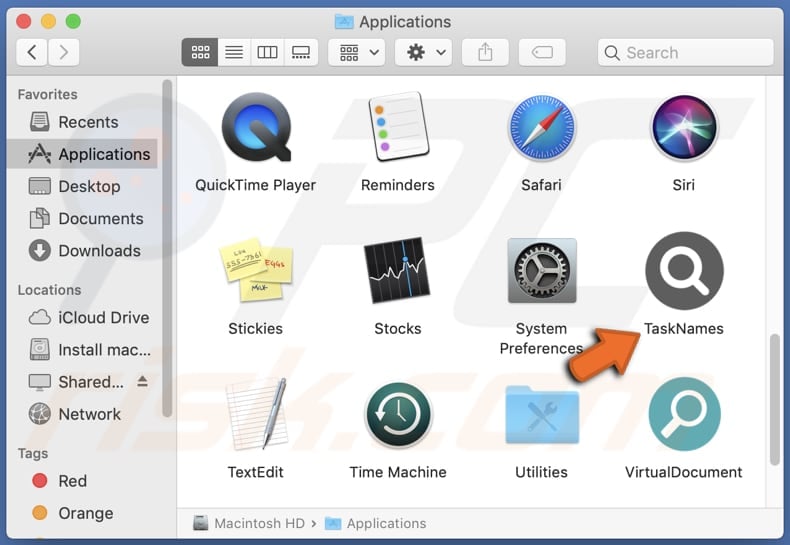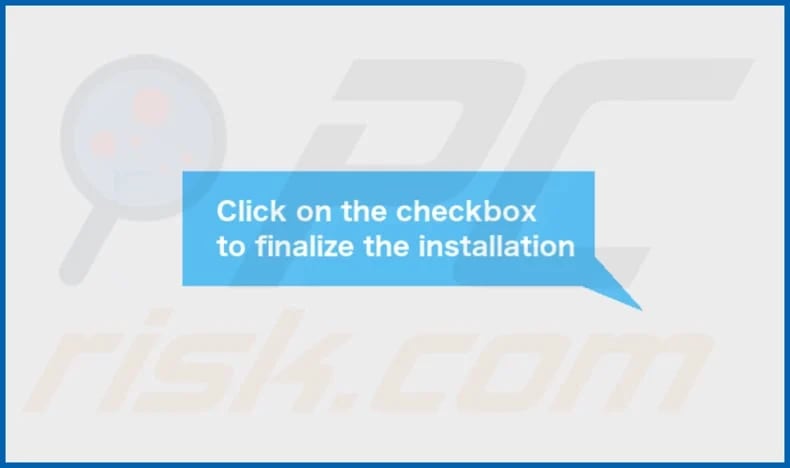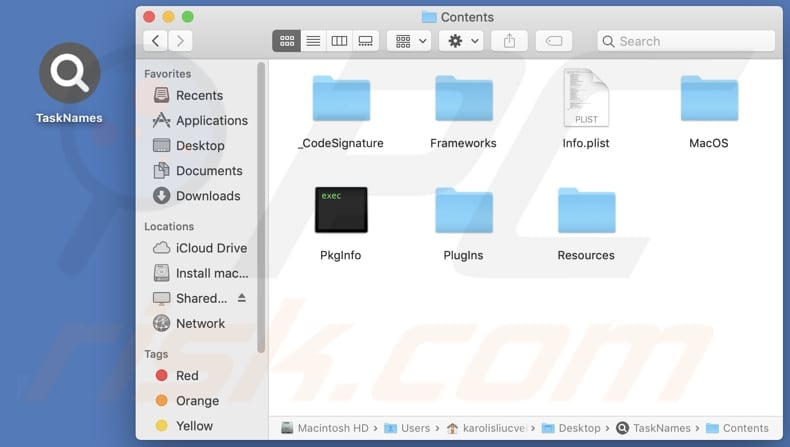Get free scan and check if your device is infected.
Remove it nowTo use full-featured product, you have to purchase a license for Combo Cleaner. Seven days free trial available. Combo Cleaner is owned and operated by RCS LT, the parent company of PCRisk.com.
What kind of application is TaskNames?
After assessing the TaskNames app, it is apparent that it displays intrusive advertisements that may lead users to unreliable websites. Such behavior categorizes it as adware. It should be mentioned that software of this type is also known for gathering user data. It is recommended to avoid installing such software on computers due to privacy and security concerns.

TaskNames adware in detail
Ads from TaskNames and similar adware may use misleading or deceptive tactics to entice users to click on them. These advertisements often make false promises or offers, such as free downloads, prizes, or discounts, to grab the user's attention. However, the content or services behind these ads may not align with what was advertised.
Interacting with these deceptive ads can lead users to security risks, including malware infections or phishing attacks. For instance, clicking on a misleading ad could redirect the user to a malicious website designed to distribute malware. Alternatively, it could prompt the user to download a seemingly legitimate software program that, in reality, is malware disguised as a useful application.
Similarly, some ads might lead users to phishing websites, tricking them into providing sensitive information like passwords or financial details. In essence, trusting ads from TaskNames or similar adware can inadvertently expose users to various security threats, putting their devices and personal information at risk.
Furthermore, adware like TaskNames often collects user data without consent, compromising privacy. This data may include browsing habits, search history, and other sensitive information, which can be used for targeted advertising or even sold to third parties. Therefore, trusting TaskNames can result in a loss of control over personal information and expose users to privacy violations.
| Name | Ads by TaskNames |
| Threat Type | Adware, Mac malware, Mac virus |
| Detection Names | Avast (MacOS:PuAgent-H [PUP]), Combo Cleaner (Gen:Variant.Adware.MAC.Adload.49), ESET-NOD32 (A Variant Of OSX/Adware.Synataeb.A), Kaspersky (Not-a-virus:HEUR:AdWare.OSX.Searchproxy.g), Full List (VirusTotal) |
| Additional Information | This application belongs to Adload malware family. |
| Symptoms | Your Mac becomes slower than normal, you see unwanted pop-up ads, you are redirected to dubious websites. |
| Distribution methods | Deceptive pop-up ads, free software installers (bundling), torrent file downloads. |
| Damage | Internet browser tracking (potential privacy issues), display of unwanted ads, redirects to dubious websites, loss of private information. |
| Malware Removal (Windows) |
To eliminate possible malware infections, scan your computer with legitimate antivirus software. Our security researchers recommend using Combo Cleaner. Download Combo CleanerTo use full-featured product, you have to purchase a license for Combo Cleaner. 7 days free trial available. Combo Cleaner is owned and operated by RCS LT, the parent company of PCRisk.com. |
Conclusion
In conclusion, the TaskNames app demonstrates concerning behavior with its intrusive advertisements and potential risks of leading users to unreliable websites. Identified as adware, it not only disrupts user experience but also poses privacy and security threats through potential data collection practices.
Given these risks, users should exercise caution and refrain from installing or interacting with the TaskNames app to safeguard their digital security and privacy. More examples of apps similar to TaskNames are RankingNetworks, FindWebResults, and CommonRemote.
How did TaskNames install on my computer?
Users often unintentionally install unwanted applications after encountering deceptive advertisements or pop-ups that coax them into downloading questionable software, offering free services, or suggesting virus removal. Moreover, inadvertent installations can occur through the utilization of P2P networks, third-party downloaders, dubious websites, unofficial app stores, and similar platforms.
Additionally, unwanted apps might be packaged with other software, and users may unknowingly agree to their installation by overlooking settings or checkboxes within installation prompts. Furthermore, certain users fall victim to social engineering tactics, such as phishing emails or messages that appear authentic but ultimately result in the installation of questionable applications.
How to avoid installation of unwanted applications?
Before downloading any app, it is wise to peruse app reviews and ratings to gain insight into other users' experiences. Stick to trustworthy sources such as official pages, Google Play Store, or Apple App Store to minimize the risk of downloading malicious software.
Always check the installer for any bundled unwanted apps when installing new software by accessing advanced or custom settings and deselecting unwanted offers. Exercise caution when encountering suspicious links, pop-ups, or advertisements on dubious web pages to prevent inadvertent downloads of malware.
Ensure your device's operating system and installed programs are kept up to date with the latest security patches. Routinely review your installed apps and promptly uninstall any that raise suspicion. Additionally, consider bolstering your device's security using reputable security software and conducting regular system scans for potential threats.
If your computer is already infected with TaskNames, we recommend running a scan with Combo Cleaner Antivirus for Windows to automatically eliminate this adware.
A pop-up that appears after the installation of TaskNames adware:

The installation folder of TaskNames:

Instant automatic malware removal:
Manual threat removal might be a lengthy and complicated process that requires advanced IT skills. Combo Cleaner is a professional automatic malware removal tool that is recommended to get rid of malware. Download it by clicking the button below:
DOWNLOAD Combo CleanerBy downloading any software listed on this website you agree to our Privacy Policy and Terms of Use. To use full-featured product, you have to purchase a license for Combo Cleaner. 7 days free trial available. Combo Cleaner is owned and operated by RCS LT, the parent company of PCRisk.com.
Quick menu:
- What is TaskNames?
- STEP 1. Remove TaskNames related files and folders from OSX.
- STEP 2. Remove TaskNames ads from Safari.
- STEP 3. Remove TaskNames adware from Google Chrome.
- STEP 4. Remove TaskNames ads from Mozilla Firefox.
Video showing how to remove TaskNames adware using Combo Cleaner:
TaskNames adware removal:
Remove TaskNames-related potentially unwanted applications from your "Applications" folder:

Click the Finder icon. In the Finder window, select "Applications". In the applications folder, look for "MPlayerX", "NicePlayer", or other suspicious applications and drag them to the Trash. After removing the potentially unwanted application(s) that cause online ads, scan your Mac for any remaining unwanted components.
DOWNLOAD remover for malware infections
Combo Cleaner checks if your computer is infected with malware. To use full-featured product, you have to purchase a license for Combo Cleaner. 7 days free trial available. Combo Cleaner is owned and operated by RCS LT, the parent company of PCRisk.com.
Remove adware-related files and folders

Click the Finder icon, from the menu bar. Choose Go, and click Go to Folder...
 Check for adware generated files in the /Library/LaunchAgents/ folder:
Check for adware generated files in the /Library/LaunchAgents/ folder:

In the Go to Folder... bar, type: /Library/LaunchAgents/

In the "LaunchAgents" folder, look for any recently-added suspicious files and move them to the Trash. Examples of files generated by adware - "installmac.AppRemoval.plist", "myppes.download.plist", "mykotlerino.ltvbit.plist", "kuklorest.update.plist", etc. Adware commonly installs several files with the exact same string.
 Check for adware generated files in the ~/Library/Application Support/ folder:
Check for adware generated files in the ~/Library/Application Support/ folder:

In the Go to Folder... bar, type: ~/Library/Application Support/

In the "Application Support" folder, look for any recently-added suspicious folders. For example, "MplayerX" or "NicePlayer", and move these folders to the Trash.
 Check for adware generated files in the ~/Library/LaunchAgents/ folder:
Check for adware generated files in the ~/Library/LaunchAgents/ folder:

In the Go to Folder... bar, type: ~/Library/LaunchAgents/

In the "LaunchAgents" folder, look for any recently-added suspicious files and move them to the Trash. Examples of files generated by adware - "installmac.AppRemoval.plist", "myppes.download.plist", "mykotlerino.ltvbit.plist", "kuklorest.update.plist", etc. Adware commonly installs several files with the exact same string.
 Check for adware generated files in the /Library/LaunchDaemons/ folder:
Check for adware generated files in the /Library/LaunchDaemons/ folder:

In the "Go to Folder..." bar, type: /Library/LaunchDaemons/

In the "LaunchDaemons" folder, look for recently-added suspicious files. For example "com.aoudad.net-preferences.plist", "com.myppes.net-preferences.plist", "com.kuklorest.net-preferences.plist", "com.avickUpd.plist", etc., and move them to the Trash.
 Scan your Mac with Combo Cleaner:
Scan your Mac with Combo Cleaner:
If you have followed all the steps correctly, your Mac should be clean of infections. To ensure your system is not infected, run a scan with Combo Cleaner Antivirus. Download it HERE. After downloading the file, double click combocleaner.dmg installer. In the opened window, drag and drop the Combo Cleaner icon on top of the Applications icon. Now open your launchpad and click on the Combo Cleaner icon. Wait until Combo Cleaner updates its virus definition database and click the "Start Combo Scan" button.

Combo Cleaner will scan your Mac for malware infections. If the antivirus scan displays "no threats found" - this means that you can continue with the removal guide; otherwise, it's recommended to remove any found infections before continuing.

After removing files and folders generated by the adware, continue to remove rogue extensions from your Internet browsers.
Remove malicious extensions from Internet browsers
 Remove malicious Safari extensions:
Remove malicious Safari extensions:

Open the Safari browser, from the menu bar, select "Safari" and click "Preferences...".

In the preferences window, select "Extensions" and look for any recently-installed suspicious extensions. When located, click the "Uninstall" button next to it/them. Note that you can safely uninstall all extensions from your Safari browser - none are crucial for regular browser operation.
- If you continue to have problems with browser redirects and unwanted advertisements - Reset Safari.
 Remove malicious extensions from Google Chrome:
Remove malicious extensions from Google Chrome:

Click the Chrome menu icon ![]() (at the top right corner of Google Chrome), select "More Tools" and click "Extensions". Locate all recently-installed suspicious extensions, select these entries and click "Remove".
(at the top right corner of Google Chrome), select "More Tools" and click "Extensions". Locate all recently-installed suspicious extensions, select these entries and click "Remove".

- If you continue to have problems with browser redirects and unwanted advertisements - Reset Google Chrome.
 Remove malicious extensions from Mozilla Firefox:
Remove malicious extensions from Mozilla Firefox:

Click the Firefox menu ![]() (at the top right corner of the main window) and select "Add-ons and themes". Click "Extensions", in the opened window locate all recently-installed suspicious extensions, click on the three dots and then click "Remove".
(at the top right corner of the main window) and select "Add-ons and themes". Click "Extensions", in the opened window locate all recently-installed suspicious extensions, click on the three dots and then click "Remove".

- If you continue to have problems with browser redirects and unwanted advertisements - Reset Mozilla Firefox.
Frequently Asked Questions (FAQ)
What harm can adware cause?
Adware poses several risks, such as intrusive ads, exposure to malware, compromised privacy through data collection, and decreased device performance due to resource-heavy ads.
What does adware do?
Adware presents unwanted ads, disrupting user experience, and can function as a browser hijacker and collect information.
How do adware developers generate revenue?
Adware developers make money by displaying ads, collecting user data for targeted ads, promoting affiliate links (participating in affiliate programs), or selling user information to third parties.
Will Combo Cleaner remove TaskNames adware?
Combo Cleaner will perform a comprehensive scan to remove all adware-type applications from your computer. It is worth knowing that manual removal is sometimes insufficient, as some files linger within the system even after the removal. Combo Cleaner eliminates adware without leaving any of its components.
Share:

Tomas Meskauskas
Expert security researcher, professional malware analyst
I am passionate about computer security and technology. I have an experience of over 10 years working in various companies related to computer technical issue solving and Internet security. I have been working as an author and editor for pcrisk.com since 2010. Follow me on Twitter and LinkedIn to stay informed about the latest online security threats.
PCrisk security portal is brought by a company RCS LT.
Joined forces of security researchers help educate computer users about the latest online security threats. More information about the company RCS LT.
Our malware removal guides are free. However, if you want to support us you can send us a donation.
DonatePCrisk security portal is brought by a company RCS LT.
Joined forces of security researchers help educate computer users about the latest online security threats. More information about the company RCS LT.
Our malware removal guides are free. However, if you want to support us you can send us a donation.
Donate
▼ Show Discussion